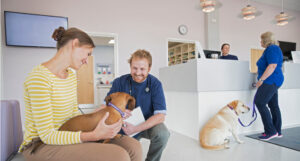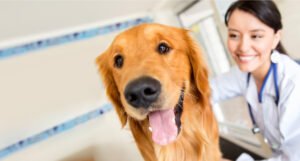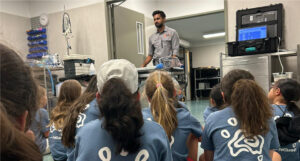The decision to become a veterinarian typically stems from a love for animals and a strong desire to help people care for them, but the job comes with many challenges.
Understanding these challenges and how you can help, leads to more positive experiences for vets, pets and pet parents alike.
Vets are a crucial part of the pet health ecosystem and yet this noble profession is suffering. Nationwide, there is a shortage of veterinarians, with a pet-to-vet ratio of 2,172 pets per practicing veterinarian. By way of comparison, there is approximately one human doctor for every 273 people. But why is the industry suffering? Let’s dive into some of the causes and ways to assist.
New veterinarians – where are they?
In 2021, the number of students enrolled in Australian veterinary science programs had decreased by just over 22% from 201012. Studies have shown that veterinary students have higher psychological distress than many other professionals, including medicine students.13 The veterinary science course is difficult, with long hours and an enormous study load, as well as having various ethical and emotional considerations not faced in other courses.
Why are veterinarians leaving the profession?
Financial stressors
Poor remuneration is cited as a cause for dissatisfaction by veterinarians, and this can be aggravated by an often incorrect perception that veterinary costs are too high. With no Government subsidy for pet health, veterinary costs are sometimes perceived as high. It is important for pet parents to consider the complexities of the industry when considering the potential costs of keeping their pet healthy. Financial preparedness is an essential part of pet ownership, whether this is by taking advantage of products like pet insurance, savings plans, or other financial services to help manage health issues their pet may face.
Job stressors
Demands on after-hours vet care is significant. Veterinarians care deeply about their patients and clients, and are frequently called upon to add several hours onto an already long, physical and mentally draining work day. Add on an intense conversation about finances when a well-meaning pet parent is not prepared for the cost of treatment, and it is easy to understand why some veterinarians may seek out industry positions with stable work hours and the ability to “switch off” when the day is done.
Advances in telehealth for pets can help to alleviate some pressure on clinics by providing triage services as well as out-of-hours support for pet patients and clients. These services have been embraced during the COVID-19 pandemic and as more veterinarians and clients see the benefits of these services as an adjunct to the essential care provided in-clinic, they may alleviate some of the pressures on clinicians.
Mental health burdens
According to research by Royal Canin and Love Your Pet Love Your Vet charity14, the incidence of suicide among veterinarians is twice as high than in other health disciplines and four times higher than the general population. The study revealed nearly 70% of Australian vets surveyed have lost a peer to suicide. Knowing this alarming statistic, what can you as a pet parent do to help your veterinarian (and in turn help your pets)?
Proactive care for pets may help to play a role in overall better welfare and health of pets and in turn more positive experiences at the veterinarian. Put another way, in practice, a particularly difficult scenario is one where a pet has been left too long with what would have been a treatable or even preventable condition before seeking out care. By the time the veterinarian has been presented with the pet patient, the pet is very unwell and the condition more difficult and more costly to treat. Some other practical ways to help make veterinary visits more enjoyable for everyone involved can include being on time for your appointments, understanding when your veterinarian is running late, and being financially prepared.
There are many organisations and initiatives such as Flynns Walk and Not One More Vet that are dedicating resources to build awareness and help with the mental health challenges facing the veterinary profession.
In 2022, GapOnly® launched GoWell™. Recognising the valuable contribution vets make to society, as well as the stressful and demanding nature of the profession, GoWell™ pledged that from 1 January 2022 for every GapOnly® claim submitted, PetSure will give $1 to GoWell™ to provide funding to causes that support the wellness of vets. The first two organisations that GoWell™ partnered with are Flynns Walk and Not One More Vet.
Being a veterinarian can be the most joyful, rewarding and interesting career, but there are currently a number of challenges facing this industry. While the issues are complex and varied, understanding these challenges and implementing ways in which we can all help to support our veterinary industry professionals together, may help create a more robust, happier and healthier veterinary industry for the future.
“We are so thrilled to receive funding and support from GoWellTM to expand our well-being offerings to people working in the veterinary field. We launched our very first ‘Cultivet Wellbeing Workshop’ to much success in 2022, with 40 industry attendees in the room, and will be running multiple workshops this year.”
Jack Levitt, president and founder of Flynn’s Walk
“Not One More Vet (NOMV) is an international organisation that provides peer support, resources, and education specifically designed to support everyone working in animal health. Veterinary professionals in Australia can seek anonymous support through our Lifeboat program, request support grants to help with financial crises, and participate in stigma-reducing mental health educational initiatives.”
Darlene Bos Executive Director, NOMV
Pet insurance can help by covering a portion of the eligible vet bill if the unexpected happens. Because it is difficult to predict the costs of veterinary care, it can help to have measures in place to help prepare for the unexpected. Check out our partner network and explore our policy tools to find a pet insurance policy.
Not all conditions or items are covered by Pet Insurance. Refer to the applicable Product Disclosure Statement for information about coverage and exclusions.



 Fact checked
Fact checked





